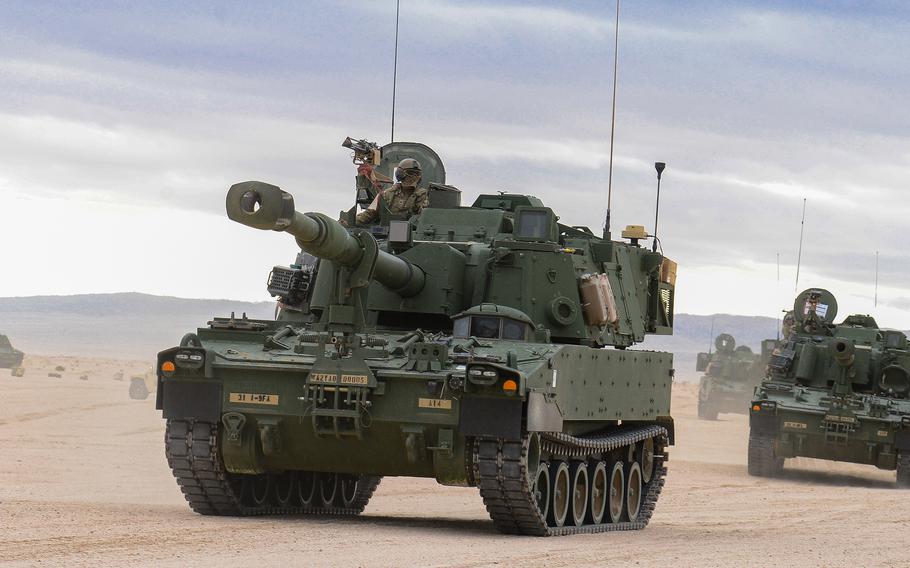
Soldiers with the Army’s 1st Battalion, 9th Field Artillery Regiment of the 3rd Infantry Division’s 2nd Armored Brigade Combat Team convoy their M109A7 Paladin howitzers across the National Training Center at Fort Irwin, Calif., during a training exercise Feb. 26, 2023. The M109A7 is the Army’s newest howitzer, and 2nd ABCT will deploy them to Europe late this summer. (Corey Dickstein/Stars and Stripes)
FORT IRWIN, Calif. — From a perch inside the Army’s newest model M1A2 Abrams tank, Sgt. Brexton Nelson spotted an enemy tank just meters away as his crew crept slowly forward over bumpy, desert landscape.
“That’s the enemy, sir,” Nelson, an Abrams gunner with 2nd Battalion, 69th Armor Regiment, advised his commander as they inched toward the rear of the target — a battle tank painted in a sand brown and green camouflage pattern.
Nelson locked the M1A2’s 120mm cannon on the other tank and fired — earning the crew its first kill hours into a weeklong force-on-force training battle at the Army’s National Training Center at Fort Irwin in the southern California desert.
Later that day, Nelson’s crew got another kill — taking out a Humvee of soldiers with the training center dedicated enemy opposing force, the 11th Armored Cavalry Regiment, known as Black Horse.
“It feels pretty good,” said Nelson, a five-year veteran of the Army who has spent the bulk of his career with the armor unit, a battalion of the 3rd Infantry Division’s 2nd Armored Brigade Combat Team. “It wakes you up. Got that one [tank] and then the Humvee, and it really feels like you’re ready to go through this rotation. We’re feeling good, confident.”
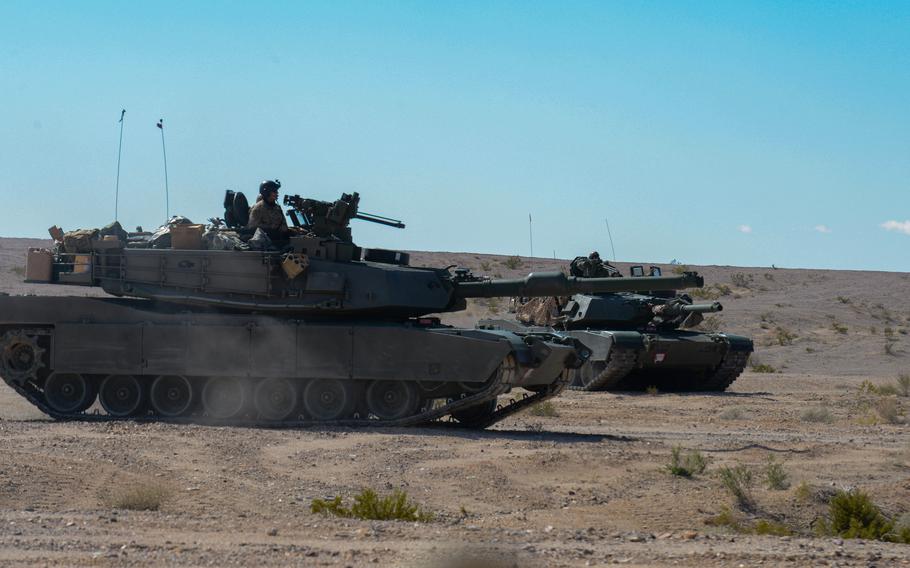
Soldiers with the 2nd Battalion, 69th Armor Regiment of the 3rd Infantry Division’s 2nd Armored Brigade Combat Team operate a M1A2 SEPv3 Abrams tanks, the Army’s most modern main battle tank, on Feb. 27, 2023, while training at Fort Irwin, Calif.’s National Training Center. (Corey Dickstein/Stars and Stripes)
The tank crew’s training kills came early in the 2nd Armored Brigade Combat Team’s training center rotation in late February into March, when the brigade left behind the flat, pine-covered training grounds of southeast Georgia’s Fort Stewart for the rough, barren, mountainous landscape that Fort Irwin has provided Army units that train there since 1981. For the unit — nicknamed the Spartan Brigade — the Mojave Desert training stop was meant to prepare them to deploy in late summer to Europe, where they will be tasked with assuring security for NATO allies and serving as a deterrent against a Russian incursion into NATO territory, more than a year after Moscow’s unprovoked invasion of Ukraine.
The rotation, which included more than one week of force-on-force battle with Black Horse and another week of live-fire training, prepared the Spartan Brigade for its forthcoming mission, said Col. Ethan Diven, the commander of 2nd ABCT, 3rd ID. Training center leaders threw many of the staples of modern warfare operations at the brigade — armed drones, masses of artillery strikes, electronic warfare operations, chemical attacks and even a trench fight.
“The focus on large-scale combat operations is something that our formation was expecting, but that we had not done with the current leaders in their positions,” Diven said after the training rotation was completed. “That was definitely a challenge. There’s a constant threat — whether it is enemy tanks, the dismount[ed infantrymen], enemy small [drones] — you have to be aware of so that you can operate in all environment types.”
The unusual weather at the National Training Center — a location best known for its dry, brutal heat much of the year — threw an extra degree of difficulty into the rotation for Spartan Brigade soldiers, who dealt with sub-freezing temperatures, heavy rains, snow and destructive winds that topped 70 mph, as California was battered with rare winter storms during their training cycle.
Brig. Gen. Curtis Taylor, the training center’s commanding general, said the rotation provided the most severe conditions that he had seen in his tenure as commander and during his own training stops at Fort Irwin. But the general came away impressed with Diven’s brigade, he said.
“It was pretty brutal for these guys. Absolutely brutal,” Taylor said, adding he was “amazed by the strength and resiliency” of Spartan Brigade’s soldiers.
For Diven, who has trained in Europe but never been stationed full-time there, the unusual snow and wind at Fort Irwin presented his brigade with an opportunity to train in conditions similar to what they could face next winter along NATO’s eastern flank.
“It can get blistery cold there,” the brigade commander said. “We know we’re going to get all of the seasons during our time over there, so … in those conditions — and because the enemy is human, just like us — when things are a little harder it presents an opportunity, not just a threat.”
‘Most modern’ brigade
When the some 4,000 soldiers of the brigade leave for Europe later this year, they will do so as the Army’s “most modern brigade” — the service’s first brigade to complete the Army’s push to modernize heavy formations. At the training center, the 2nd Armored Brigade Combat Team brought its arsenal of 87 new M1A2 SEPv3 Abrams tanks, 125 M2A4 Bradley Fighting Vehicles, 13 M7A4 Bradley Fire Support Team Vehicles and 18 M109A7 Paladin self-propelled howitzers — the Army’s newest and most deadly versions of the weapons that anchor a heavy brigade.
The National Training Center provided the brigade its first opportunity to simultaneously use all the new weapons, which cannot all operate in the field together on the smaller training grounds at Fort Stewart. At Fort Irwin, the brigade spread out across much of the center’s 775,000-acre training area — a tract of land roughly the size of Rhode Island — known as “the Box,” allowing all those new platforms to work together. The weapons performed as advertised, Diven said.
Among the advantages they bring — in addition to improvements like better armor, remotely operated guns and more power generation — are new digital capabilities that provide enhanced communications and give soldiers access to operations and training manuals on a searchable tablet instead of the paper manuals of the past. Soldiers said those capabilities, which one compared to “Google for tankers,” mean less time spent troubleshooting issues and quicker fixes when problems arise.
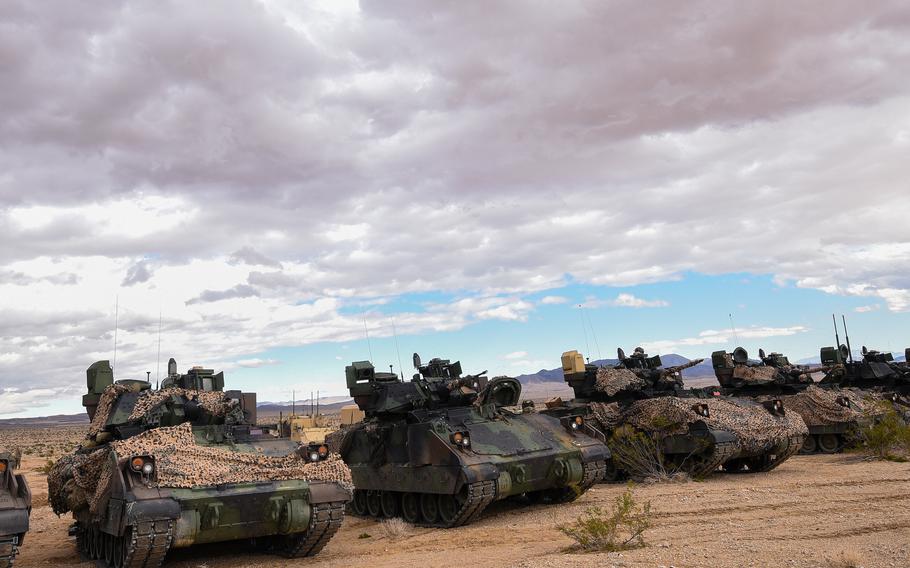
M2A4 Bradley Fighting Vehicles from 2nd Armored Brigade Combat Team, 3rd Infantry Division line up during a pause in fighting Feb. 27, 2023, during a force-on-force battle at the Army’s National Training Center at Fort Irwin, Calif. (Corey Dickstein/Stars and Stripes)
For warfighting, Taylor said National Training Center leaders noticed the brigade had at least two substantial advantages to most of the units that rotate through the center. One was increased weapons readiness, which he and Diven attributed partly to the new platforms being in better shape than the older equipment most brigades have been using.
But the improved communications abilities proved deadly in the fight, Taylor said.
The Spartan Brigade’s counter artillery fire left Black Horse commanders “frustrated in the opening days” of the battle, the general said.
Black Horse soldiers have built in advantages over the training brigades. They spend years training at the center and know the land and how to defend it extremely well. Taylor said typically when units bunch vehicles up, Black Horse hits them with artillery from well-hidden positions.
Against the 2nd Armored Brigade Combat Team last month, “every time [the Black Horse commander] fired he would lose guns — every single time he fired,” Taylor said, attributing that to Spartan Brigade’s training and abilities on its new weapons platforms. “So, every time he shoots, his guys are dying, so he had to raise his threshold and say, ‘I’m not going to shoot at everything I see. I’m only going to shoot at what I know I really need to kill, because I might lose two artillery pieces in trying to kill that.’”
Diven said his soldiers had prepared well during individual and small-unit training exercises at Fort Stewart the previous several months. He said he was impressed with his troops' ability to quickly master the new weapons. That carried over to the Fort Irwin rotation, he said.
The brigade commander noted his soldiers had higher-than-normal combat readiness rates on the older Army platforms that the brigade still uses, such as the M113 armored personnel carrier.
“So, I think it speaks to young leaders driving … a kind of a culture of maintenance and the importance of taking care of our stuff,” Diven said. “Because if it's broken then it can't get in the fight, and our brigade definitely got into and stayed in the fight.”
The brigade’s top enlisted leader, Command Sgt. Maj. Jason Mikan said even with the newest weapons, soldiers must prepare properly to succeed in combat — or against the training center’s opposing force.
“You can have the best tank in the world, but it takes a crew to make it go,” Mikan said. “There's a proficiency of the crews that led to the lethality, not necessarily just the [new] platforms.”
Soldiers, nonetheless, have been impressed with their new weapons.
Nelson, the tank gunner with 2-69 Armor, said the SEPv3 Abrams had advantages over the prior version of the tank that he had spent most of his Army career manning. The new tank provides more energy over its older version to power technology, including communications networking and remote weapons systems as well as improved armor meant to better shield crews from blasts detonated underneath the tank.
But Nelson said his favorite advantage is the improved situational awareness that it provides crew members while operating. Nelson can lock onto a target while another crew member searches for other enemies on a separate electronic sight, which provides tank commanders 360-degree views of their surroundings.
“If I’m getting ready to shoot this target over here, and I don’t see anything else around me, [and] my tank commander spots another enemy over here to the left, he can designate it, and when it’s time [the system] will rotate the turret automatically to that target,” Nelson said. “He’ll mark them, and as soon as I can see them, I can destroy those troops.”
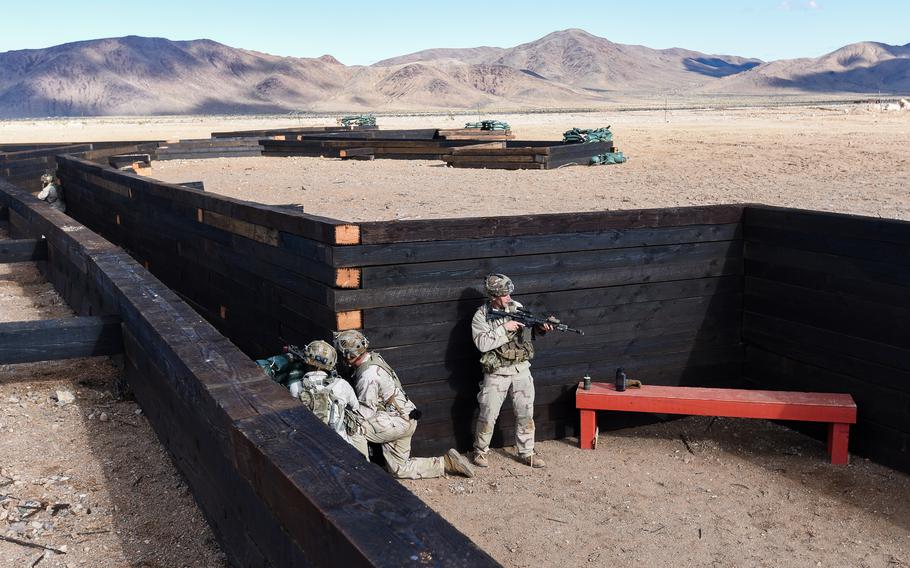
3rd Infantry Division soldiers, serving as part of the opposing force, man fighting positions inside a trench during a force-on-force battle at the Army’s National Training Center at Fort Irwin in California’s Mojave Desert on Feb. 26, 2023. (Corey Dickstein/Stars and Stripes)
The first battle
The National Training Center’s mission since its founding has not changed, said Taylor, the commanding general. The massive battleground is designed to train Army formations to win the first battle of the next war.
“It’s our very simple and clear mantra,” Taylor said.
So, training center leaders have spent recent years watching closely how modern armies fight each other, Taylor said. They watched Armenian and Azerbaijani forces fight in 2020, using advanced surveillance techniques such as sending small drones to identify targets for long-range artillery and quickly strike. In Ukraine, they have watched the war become a trench-based artillery duel.
“So, part of my job is to visualize what that first battle of that [next] war is going to look like, and then expose units to the worst possible conditions they could face in that battle,” Taylor said.
For the U.S. military, gone are the days of training for combat missions in places such as Afghanistan and Iraq, where U.S. military power and access to the most modern weapons ensured an uneven playing field over insurgents such as the Taliban, al-Qaida and the Islamic State terrorist group. The next fight, Pentagon officials believe, might be against a military with similar combat capabilities to the United States — potentially China or Russia. That kind of military power is what Taylor aimed to throw at the 2nd Armored Brigade Combat Team.
Part of the key, Taylor said, is the “world-class opposing force" provided by Black Horse, which is outfitted with modern weapons and fights using hybrid tactics — large-scale combat power and staples of insurgencies such as improvised bombs and booby traps. This is based primarily on Russian tactics, Taylor said.
In the scenario at the training center, the Spartan Brigade found itself in an adversary nation, where the fictional Donovian Army invaded a partner country, Atropia, setting off a large-scale war. The 2nd Brigade was tasked with backfilling a tired Atropian brigade and pushing the Donovians out of Atropian land in nine days.
Aside from the brutal weather, 2nd Brigade soldiers noted the enemy proved difficult to fight at Fort Irwin. However, the unit grew more confident the longer they spent in the desert.
Sgt. William Hader, a forward artillery observer with 2nd Brigade’s 6th Squadron, 8th Cavalry Regiment, said several days into the fight with Black Horse, his unit was adapting to their tactics. Hader, a veteran of combat in Afghanistan, said the large-scale operations that the unit was preparing for made operating more difficult than in Afghanistan.
“We don't know the enemy, and so we're always on the lookout,” he said. “You never know what you're coming across. And it is posing a really great challenge. But overall, this is a great learning lesson for myself and my team, and we're honestly really enjoying it, and we’re getting better.”
A couple of days into the force-on-force fight, Hader said his crew spotted dismounted infantry in the distance and quickly called in a mortar strike, taking out four enemy forces. It was a confidence booster.
Should they be called to fight after deploying to Europe, Hader said U.S. troops understood it would likely be a drastically deadlier fight than the wars in Afghanistan and Iraq during the past decades.
“If the enemy has the same capability as I [have], he's probably thinking the same thing I am, right?” Hader said. “If I feel like if I slip up at any given moment, that could be it.
“It’s high casualty warfare. It’s a totally different fight.”
For that reason, Taylor said he instructs Black Horse to fight aggressively. It is also the reason that he instructs them to hit training brigades with repeated swarms of small, cheap armed drones and relentless barrages of artillery fires and to use electronic capabilities to knock out communications platforms.
It is also the reason that Taylor ordered Black Horse to build a new trench at one of Fort Irwin’s many urban training locations.
“We built that trench line because of what we saw happening in eastern Ukraine,” Taylor said. “We said ‘We’ve got to figure out how to fight in these trench lines.’ So, we’re adapting to what we’re seeing on the modern battlefield.”
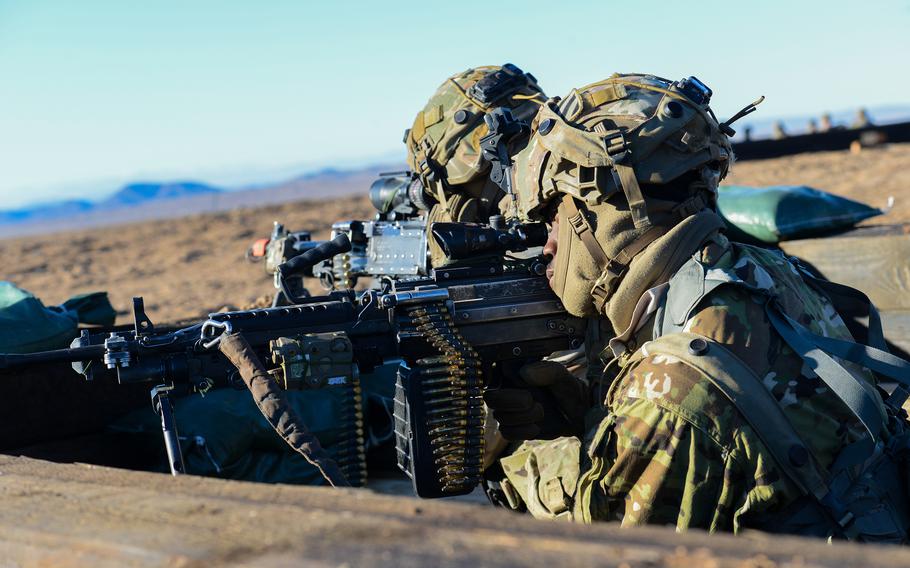
3rd Infantry Division soldiers man fighting positions inside a trench during a force-on-force battle at the Army’s National Training Center at Fort Irwin in California’s Mojave Desert on Feb. 27, 2023. (Corey Dickstein/Stars and Stripes)
When 2nd Brigade soldiers attacked the new trench manned by opposition force troops, the fight became a “knife fight,” at times, Taylor said, with troops yelling over each other that one had “killed” the other before he was killed. Despite such breakdowns that a simulated battle might produce, Taylor said it was important those troops learn to clear a trench because their next battle might be inside one.
During the nine-day, force-on-force fight, the distance that the Spartan Brigade soldiers had to cover was roughly the same as the distance between the Belarus-Ukraine border and Kyiv, the Ukraine capital, Taylor said. Russian forces in the early days of the war in Ukraine struggled to move supplies and backfill forces across that same distance.
“Just think about how many logistics problems and sustainment problems that the Russians had in that 100- to 130-kilometer movement,” Taylor said. “Well, we do that every … month out here, we do that same distance, because that's really, really hard.”
That amount of space to operate, Taylor said, is what makes the National Training Center so valuable for heavy Army formations. That’s the primary reason that a unit such as the 2nd Armored Brigade Combat Team, which will deploy to Eastern Europe and not the deserts of the Middle East, can continue to train at Fort Irwin to prepare for its next mission.
“The thing we can create here is the effect of having to move 150 kilometers with continuous fighting,” Taylor said. “And there's no forest anywhere inside the continental United States where we can do that, and so we're able to replicate the problem of distance, which is the true tactical problem that they have to overcome.”
Taylor said if units such as the 2nd Armored Brigade Combat Team can succeed at Fort Irwin against Black Horse, they can win a fight anywhere in the world and likely against any opponent.
“This is the toughest terrain, toughest environment — if they can fight here, then they could win over there,” the general said.
The 2nd Armored Brigade Combat Team, which recently returned to Fort Stewart, will spend the coming weeks unloading their equipment from the training center rotation and finish preparing for their late summer deployment, said Diven, the brigade commander.
At Fort Stewart, the unit will go through individual and small-unit, live-fire sessions and prepare on some tasks specific to Europe, he said. Then they expect to spend nine months in Europe, training with NATO heavy units to ensure their new platforms and communications abilities work well with the gear of their allies. The unit will also complete another combat training center rotation — this time at the Joint Multinational Readiness Center at the Army’s Hohenfels Training Area in Germany.
Diven said he believes his unit’s morale is high as it prepares for the Europe rotation. More than 120 Spartan Brigade soldiers chose to reenlist in the days since the unit came home from the National Training Center, the colonel said.
“So, after this resiliency event — pulling all this equipment and fighting in the snow and the burden of being away from home, they still said, ‘Yeah, I want to keep serving,’ ” Diven said. “So that’s an indicator, to me, of how the soldiers experienced — and even enjoyed — NTC. And, I’d say they’re going to be 100% ready to go [to Europe.]”
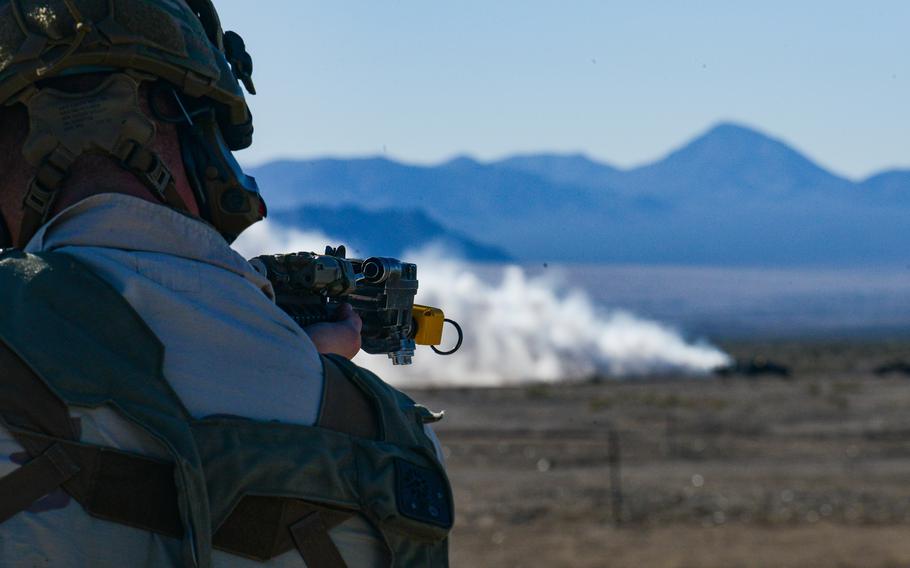
A member of the opposing force looks down his carbine as members of the 3rd Infantry Division’s 2nd Armored Brigade Combat Team approach his position during a force-on-force fight at the National Training Center at Fort Irwin, Calif., Feb. 26, 2023. (Corey Dickstein/Stars and Stripes)